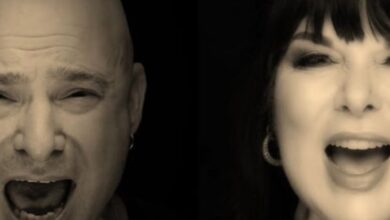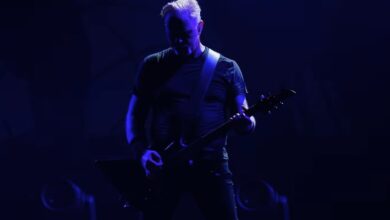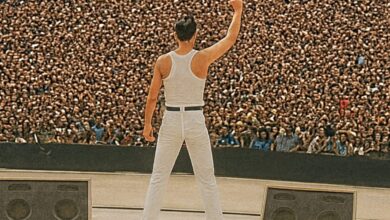Disturbed’s “Don’t Tell Me” Featuring Ann Wilson Bridges Generations and Souls
On a cold January night in 2024, Disturbed stepped onto the stage radiating intensity and focus. The packed arena hummed with anticipation, fans exchanging excited glances as the first haunting chords of “Don’t Tell Me” emerged from the shadows. The sound began softly, almost uncertain, then gathered strength until it filled the hall. Instantly, the audience realized this would be more than just another concert. As the lights dimmed and the full force of the song took hold, every eye fixed on the stage, ready to witness something unforgettable—the rare union of two generations of rock passion and truth.
From the very first verse, the chemistry between David Draiman and Ann Wilson transformed the performance into an emotional duel of power and vulnerability. Draiman’s raw, textured delivery intertwined seamlessly with Wilson’s crystalline authority, creating a sonic dialogue that bridged eras. Wilson stood poised at stage left, her presence regal yet grounded. When their voices met for the first time in harmony, the air seemed to crackle; Draiman’s gravel and Wilson’s clarity fused into a perfect storm of sound. It was less a duet than an eruption—a merging of two immense spirits that commanded the space with mutual respect and fire.
The arrangement gave both singers room to shine while amplifying the tension between light and shadow. During heavy sections, the guitars surged with a metallic roar, while the quieter parts pulled back to reveal delicate piano chords and the hum of strings beneath Wilson’s soaring phrases. Draiman often yielded in these moments, allowing her voice to float freely before reentering with renewed strength. The balance between aggression and grace, between release and restraint, kept listeners hypnotized. Each shift in dynamic felt deliberate, as though the band had rebuilt the song piece by piece for the live stage.
The visual spectacle heightened the drama. Spotlights bathed Wilson in a warm glow as she reached her towering notes, while bursts of strobe light and shadow punctuated the heavier climaxes. Fans who came expecting Disturbed’s usual ferocity found themselves chanting Wilson’s name, captivated by the mix of elegance and raw emotion. At one point, Draiman extended his hand toward her, their voices locking as one—a gesture of artistic unity that echoed through the arena. Cameras caught the moment instantly, and it spread online within hours, becoming one of the most shared images of the night.
Midway through, Wilson took complete command of the room. As the band eased into the bridge, her voice rose effortlessly into the upper register, sustaining notes that seemed to hang in the rafters. The audience fell utterly silent, watching a master at work. Behind her, faint backing vocals shimmered like distant echoes. When Draiman’s deep tones returned, they didn’t compete—they encircled her lines, amplifying the emotional gravity. Together, they transformed the chorus into a storm of catharsis, their combined power shaking the room to its foundation.
Then came the unscripted moment that fans would never forget. Wilson lingered on a note longer than expected, adding a delicate run not present in the studio version. It was pure instinct, a spark of improvisation that electrified the air. Draiman answered immediately with a growling sustain of his own, and the crowd erupted. In that instant, it was clear that this wasn’t just a recreation—it was living art unfolding in real time. The spontaneity gave the performance a human pulse, the kind that turns a concert into memory.
As the final chorus thundered to a close, the band let the last chord hang suspended before cutting to silence. The reaction was explosive—cheers, whistles, and waves of applause cascaded through the arena. Some fans clutched their faces, others cried openly. The musicians exchanged smiles, and Wilson lifted her hand in quiet triumph. For that brief, suspended moment, everyone inside the hall knew they had witnessed something rare: a performance that transcended its own medium, turning shared emotion into collective awe.
Backstage afterward, laughter and exhilaration filled the air. Draiman and Wilson embraced, joined by the band members in mutual congratulations. They spoke of how seamlessly the delicate transitions had landed, and how the audience’s reaction had validated every risk. That sense of artistic connection, where performer and crowd feed off one another’s energy, became the night’s defining theme. In later interviews, both artists described the experience as a creative high point—proof that collaboration can still surprise even the veterans of the stage.
Music critics reacted within hours, their reviews glowing and detailed. Some called it a bridge between generations, celebrating how Wilson’s timeless vocal presence fused with Disturbed’s modern aggression. Others noted how Draiman’s emotional openness gained new dimensions beside a voice as storied as Wilson’s. Even skeptics of the pairing admitted that it felt bigger than novelty—something rooted in authenticity rather than marketing. The consensus was clear: the performance captured lightning in a bottle, an unrepeatable moment of courage and chemistry.
Online communities buzzed through the night. Fans clipped and shared the key moments—their first harmony, Wilson’s sustained high note, Draiman’s closing salute. Social media feeds filled with admiration and disbelief. Heart fans discovered a new respect for modern metal; Disturbed devotees found themselves exploring Wilson’s legendary catalog. Hashtags trended, reaction videos multiplied, and one phrase repeated everywhere: “This is what rock is all about.” It was more than viral—it was generational unity made audible.
Dan Donegan later reflected on how deeply personal the song had become for the band, explaining that Wilson’s involvement magnified its emotional heartbeat. He revealed that there had been early doubts about whether such a collaboration would feel natural, but the live rendition proved the opposite. Wilson didn’t overshadow the message—she illuminated it. For her part, Wilson spoke of rediscovering her own edge within Disturbed’s modern framework, calling it one of the most invigorating performances of her career.
Later performances continued to feature Wilson at select stops, each one drawing sold-out crowds eager to relive the magic. While every show carried its own spark, none quite matched the unfiltered emotion of that first night. Bootleg videos circulated, shaky but heartfelt, capturing the sound of thousands of voices singing together. Even with imperfect audio, the power of connection bled through—the rawness, the gratitude, the awe of seeing two legends meet at the same emotional altitude.
As the tour expanded, the band adjusted arrangements and lighting to highlight Wilson’s moments even more. Every element—from the choir harmonies to the swelling lights—was fine-tuned, but the performers insisted on keeping the element of risk alive. That tension between precision and spontaneity gave each show its electricity. Fans understood that what made the collaboration special wasn’t flawlessness—it was honesty, the fearless act of singing from the edge.
Beyond the music itself, the collaboration carried a deeper message about rock’s evolution. It showed that the genre’s torch doesn’t need to pass from one generation to another—it can be shared. Wilson’s decades of artistry met Disturbed’s modern ferocity in a way that felt like a dialogue, not a handoff. It reminded audiences that real rock isn’t confined by age, sound, or trend—it’s defined by spirit, truth, and the willingness to feel everything out loud.
Months later, fans still ranked that performance among the defining moments of the tour. Online polls listed it as one of the most powerful live collaborations in recent memory, and streams of the studio version surged. The impact rippled beyond the stage, breathing new life into both artists’ catalogs. For many, it wasn’t just a highlight—it was a touchstone, proof that music could still unite hearts across decades and styles with a single, shared roar.
What lingered most was the feeling it left behind—the electricity of two commanding voices finding each other midair and holding nothing back. That night reminded everyone why live music matters: because sometimes, just sometimes, it captures the full range of human emotion in one shared breath. Disturbed and Ann Wilson didn’t merely perform “Don’t Tell Me.” They embodied it, turning pain into beauty and collaboration into history. And long after the lights went down, the echo remained.





